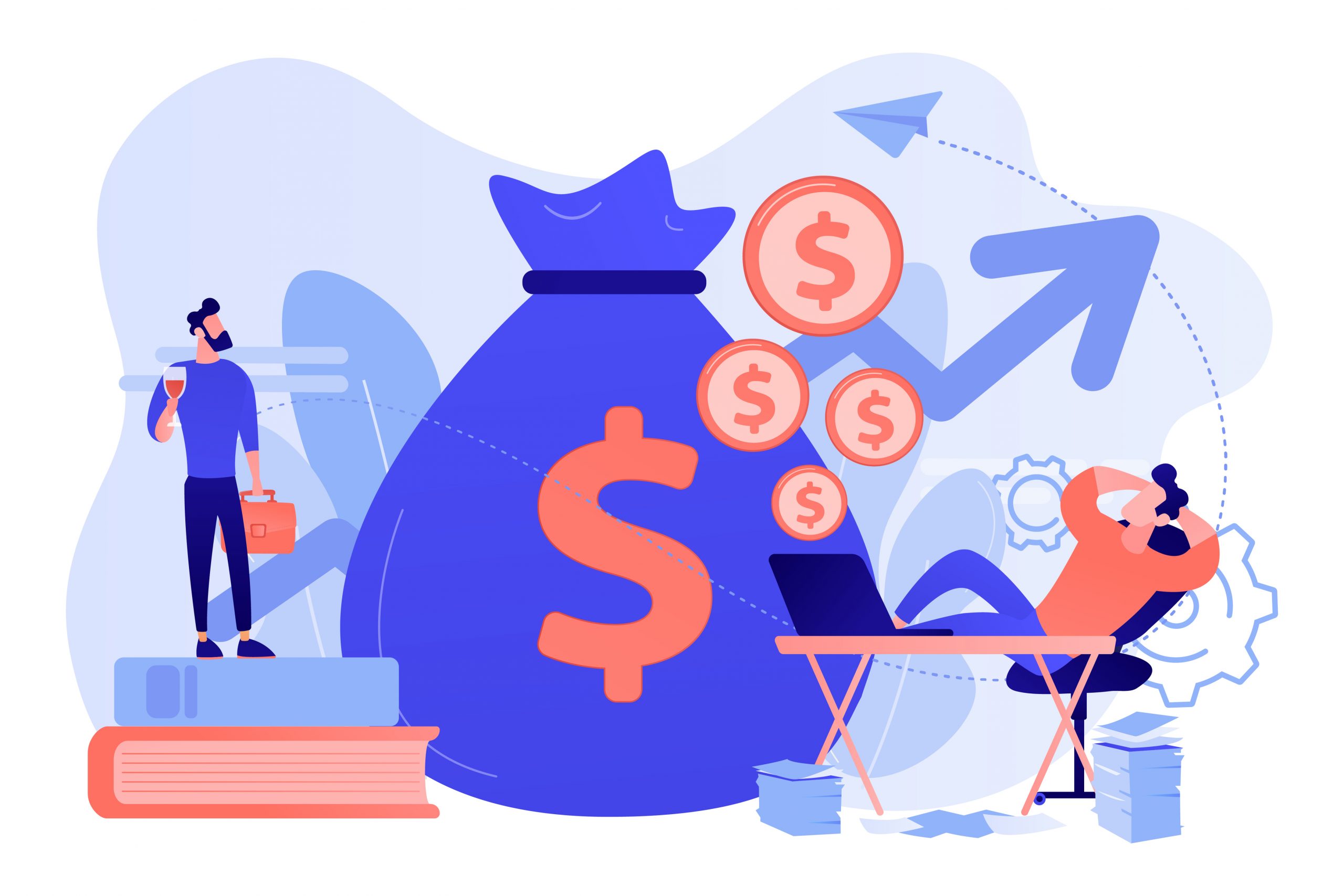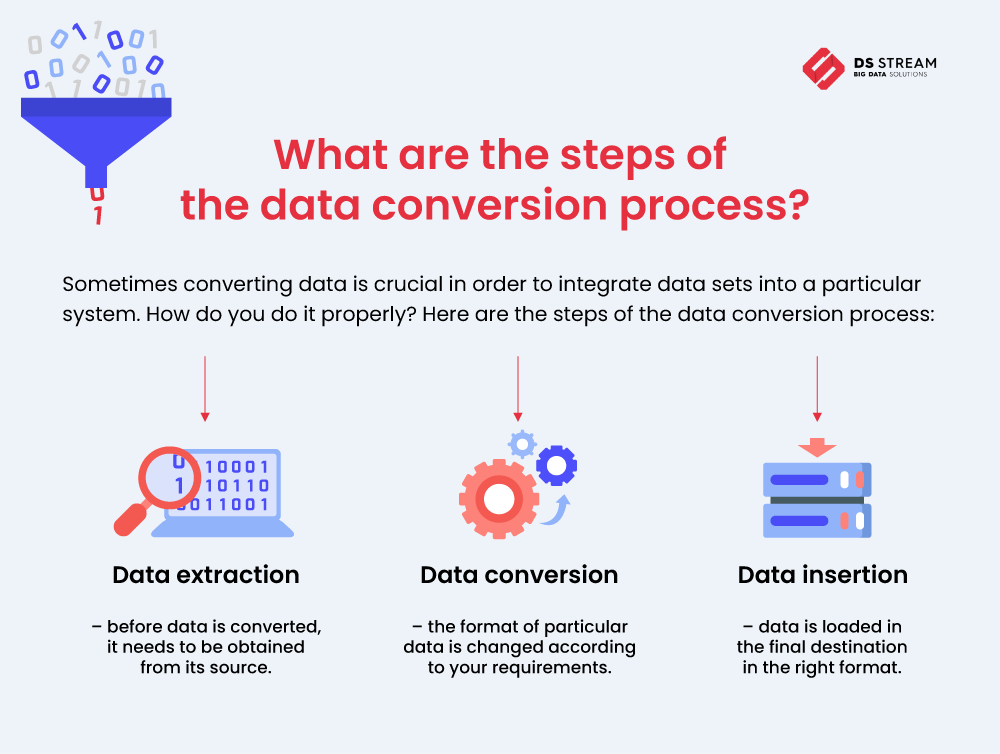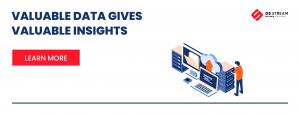
-
12 April 2022
- Big Data
We have entered the “digital era”. Nowadays, companies can benefit from multiple business tools and systems which use gathered business data in order to improve their efficiency. However, not all the collected information will be ready-to-use for analytics, automation, or targeting. Data conversion can help you overcome some of the significant challenges on your way to success.
Data drives our world. All the companies generate it, collect it and process it in one way or another. More and more companies are leveraging advanced technologies, contact customers via the web using various channels of communication, or offer online services. Therefore, such organizations deal with huge amounts of data. Some collected information will prove to be very useful for the business, while some won’t (or at least not in the original form). You need to make sure that you process your business data as efficiently as possible. How do you do this? By following all the data management good practices that enable you to preserve the high quality of data you’ve gathered. Data conversion can even help you make good use of data that may seem useless at first glance.
What is data conversion?
The goal of the data conversion process is to translate data from one format to another. It is very often necessary to have data in a specific format in order to integrate it with a particular system, as some programs can be incapable of reading and using data if they aren’t in the correct form. It may be crucial to convert data if you have implemented (or are planning to implement) a new application or database, and you want to use some of the information you’ve stored in your old databases.
There are several processes that may seem a little bit like data conversion. As a matter of fact, businesses process data in many ways, so don’t mistake data conversion with:
- Data migration – this is the process of moving entire databases (with all stored data) to another location (for example, a different system).
- Data cleaning – during this process inaccurate, incomplete or doubled data are found and fixed or deleted from the dataset.
Properly performed, the data conversion process prevents data loss or corruption and allows your company to take full advantage of the business information you collect. Of course, converting data is not easy and there are some obstacles along the way that can hold you back. Make sure you know all about them and how to prepare your organization in order to overcome them easily.
Challenges in the data conversion process
Losing important business information or receiving inaccurate analysis as the result of low quality data can negatively affect your company’s efficiency. Converting data may sound easy, but it is actually quite a complicated process. That is why you have to make sure that you have thought through all the possible challenges that you can encounter on the way.
The risk of losing information during data conversion is real. Think of it – when you convert a simple DOC file into a TXT, you are losing all the formatting you have performed on text. You won’t be able to see it or retrieve it, even if you convert the TXT file back to a DOC. That is because of the structural differences of the files. So how can you prevent such problems? By creating a good data conversion plan and using the best available tools.
Data conversion strategy
You need to make a good plan for your data conversions. As we mentioned earlier, the data conversion process can be quite complex – or even difficult to perform without the right strategy and conversion tools. A data conversion plan has to be prepared according to the unique requirements of the user. Why is the data conversion strategy so important? It helps you protect not only the quality of the data, but it also helps you protect the accuracy of the data and improve the efficiency of the entire process. You need to consider the type of data you’ll be working on. Is this sensitive data, crucial documents, internal reports or maybe a combination of different kinds of data? Where is the information stored? In an archive or in databases that are currently in use? How can you extract the data? And of course, there is another, very essential question: in what format do you need your data?

The stages of the data conversion process are as follows:
- In order to be converted, data first needs to be extracted from its source.
- Then data can be converted into the format expected in the system or a database that will be its final destination.
- Finally, it is time to load the data to the target system.
There are also two types of conversion you need to know about. When we perform an implicit conversion, a compiler performs the conversion automatically. During this process, one piece of data is compared to another, and after that, source data is assigned to the proper destination data type. An explicit conversion is more complicated. Objects and data can be converted in three ways:
- Before the conversion, a runtime check is carried out in order to determine if the destination data type can hold the source value. If it is not possible, an error occurs.
- No checks are performed. Even if the destination data type cannot hold the source value, there is no error. Simply, the resulting data type stays undefined.
- The bit pattern is copied, but data is not interpreted.
As a matter of fact, the entire process of converting the data differs based on the programming language you use. Those who use strong-typing languages usually perform explicit conversion, while those who code in weak-typing languages will rather choose implicit conversion methodology. The fastest and most efficient way to convert data properly is by using a data management platform that enables automation of the conversion process.
Are there any interesting data conversion systems available?
There are many data conversion programs and tools for automating this process. They allow you to avoid many problems along the way and improve the accuracy and completeness of the converted data. Using such tools, you can also significantly reduce the time needed for data conversion, which will positively affect other processes in your organization.
The best data conversion system should be flexible and customizable, so you could adjust the final result to your individual needs. This type of tool needs to automate various processes in the data conversion process. And finally, the goal of the conversion is to receive exactly the same data, but in a different format – the proper tool will ensure the highest quality and safety of the information that is being converted.
Data conversion services
Carrying out data conversion in-house may not be easy, but that doesn’t mean that you are not able to leverage your business potential fully. If you don’t possess the right tools, or your staff doesn’t include the professionals experienced enough to perform the data conversion process properly, we’ll be happy to assist you. We can help you with converting your business data so you can use it. Check out our services or contact one of our specialists directly in order to discuss our offer.
Check out our blog for more details on data:


